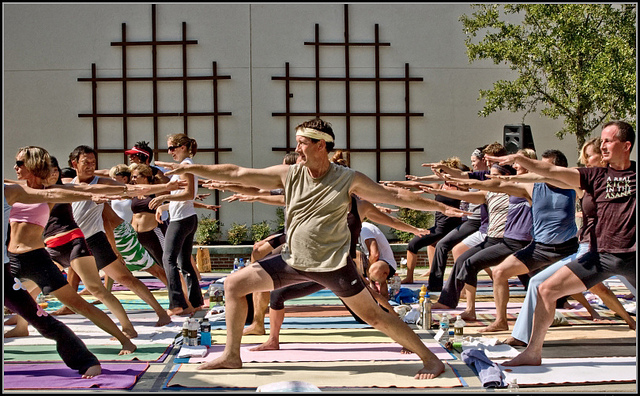rabble is expanding our Parliamentary Bureau and we need your help! Support us on Patreon today!
Here’s the problem with the debate about the appropriation of yoga: it’s simplistic.
Without a doubt, the yoga practised in the western mainstream is commercialized, shallow, and devoid of a rigorous philosophical tradition. In South Asia, people just don’t become yoga teachers overnight, and yoga isn’t about striking a pose.
At the same time, the defense of a pure Yoga from South Asia ignores regional differences, caste-based oppression, and gender-based violence within Hinduism. Identity, culture, and spirituality are historically specific, fluid, and often very much contested.
Let’s consider the Western yogi’s handbook, the song of God herself, the ancient holy text called the Bhagavad Gita. The Gita captures a moment frozen in time, a conversation between the warrior-prince Arjuna and his charioteer Lord Krishna (who just happens to be the eighth incarnation of God).
The battlefield is divided between Arjuna’s clan the Pandavas and on the other side of the red line his notorious cousins the Kastriyas. Flags wave, drums beat, and soldiers draw their weapons. With the battle set to commence, Arjuna suddenly breaks down, overcome with sobering sadness about killing his own family and childhood friends.
Krishna counsels Arjuna about performing his duty (dharma) with no concern for the fruits of his actions. The Gita is part of a greater canonical tradition in India and fits into the narrative of the Mahabharatha. In one story, Dronaacharya rejects a young Ekalavya as a student because he is from a lower caste. The boy is a capable archer in his own right and sets out to refine his skills alone. Eventually Dronacharaya agrees to make Ekalvya a student for a price: the younger disciple’s left thumb.
No longer a threat, a capable archer, or potential rival to Arjuna, Ekalvya is hailed a model of discipline and obedience. A far cry from the peace-loving spirituality imagined by many white yoga practitioners.
But cultural appropriation is a reality. One colleague told me she’s not interested in establishing inner peace — burning 300 calories is her biggest draw to yoga. The Gita would admonish Western yogis obsessed with their physical beauty, warning us about the pitfalls of over identification with our physical bodies, subject to old age, illness, and death. A far cry from hot yoga classes and the skinny white women we see in the mainstream.
As one friend observed, “When we forget capitalism in our analysis, we spin out in all sorts of weird ways.” Indeed, yoga is now a multi-million dollar industry in the West. And, without a nuanced analysis of identity we strike all sorts of strange poses too.
Identity is fluid. Our well-intentioned efforts to curb cultural appropriation should avoid entrenching orientalist ideas about Indian spirituality. Otherwise, we risk silencing the region’s subaltern voices that resist particular narratives.
Krisna Saravanamuttu practices Vipassana meditation and is a Masters candidate in Socio-Legal Studies at York University. You can follow him on Twitter @KrisnaS85
rabble is expanding our Parliamentary Bureau and we need your help! Support us on Patreon today!
Image: Flickr/Matt Olsen




